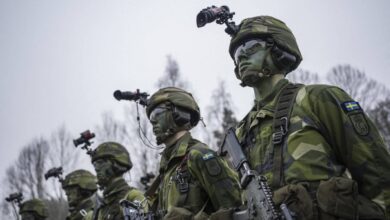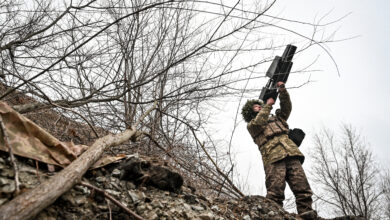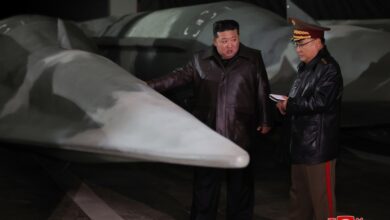
Since 1949, NATO has been a cornerstone of European security and the transatlantic alliance. Yet, with two North American members and 80 percent of its expenditures coming from non-EU countries, there is a glaring need for an independent European military.
Calls for this capability have come loudest from French President Emmanuel Macron, but also from EU High Representative for Foreign Affairs and Security Policy Josep Borell and German Chancellor Olaf Scholz.
In fact, support for independent EU defense has consistently polled over 70 percent among EU citizens since 2000.
Need for Uniquely European Military Response
There are numerous European issues that demand a European military response.
Take, for example, last year’s migrant crisis on the Polish-Belarussian border. A unified European military may have deterred Belarussian President Alexander Lukashenko from using migrants to assault the EU in the first place and could provide logistics and resources to Poland.
Currently, 6,000 Polish troops are defending what is essentially the EU’s external border — and they’re doing it alone. Similar scenes are happening with the militaries and on the borders of Lithuania, Latvia, and Estonia.
Most pressing is the current Russian invasion of Ukraine. An EU military could train Ukrainian forces in Hungary, Poland, Slovakia, or Romania, provide materiel and support the mass migration of Ukrainian citizens to the EU.

The Russian Federation spends just 55.5 billion euros ($62 billion) on its military. The combined defense expenditures of the EU are nearly 200 billion euros ($223 billion).
A collective EU force would starkly change Europe’s balance of power and force Russian President Vladimir Putin to recalculate how he projects power on the continent.
Architecture of a European Army
Luckily, the framework of a unified European military is already in place.
Eurocorps is a multinational force for both NATO and the EU, being a part of the former’s command and control but available for the latter’s missions. It is headquartered in Strasbourg, France, and is deployed under the authority of its own Common Committee, made up of its current member states.
Today it only has 1,000 soldiers, a far cry from a true corps, which typically has between 50,000 to 300,000. To put this in perspective, the Russian forces massed on the border with Ukraine immediately before the invasion was about 150,000 strong.
Associate members on the continent are permitted to join Eurocorps, namely Turkey. Some European states, like Sweden, have up until now ruled out joining NATO to remain neutral in a potential European conflict.
An EU defense force could provide them the political cover to do so, while offering defense guarantees. Finland, another EU nation that has yet to join NATO, was an associate member of Eurocorps from 2002 to 2006.
Expanding Eurocorps
Eurocorps should be expanded to the size of a true corps, with personnel from all EU states, and entered into the EU’s Common Defense and Security Policy. This would allow for the force to be under the authority of the European Council.
An expanded Eurocorps is not meant to replace NATO’s transatlantic alliance; it’s meant to strengthen it. Twenty-one of twenty-seven NATO countries are in the EU. An additional four NATO members (Albania, Montenegro, North Macedonia, and Turkey) have applied to join the union.
The Berlin Plus agreement, signed in 2002, permits the EU to draw NATO equipment for operations that NATO declines to participate in. Thus, a unified European defense force would only enhance NATO interoperability.
Like NATO Article 5, the EU already has a mutual defense clause.

Article 42.7 of the Treaty of Lisbon states that if a member is the victim of armed aggression, other members are obligated to aid it by any means necessary.
Furthermore, Article 222 in the Treaty of Rome says that members shall mobilize military resources in response to terrorist attacks and natural or man-made disasters.
EU Military Cooperation
If EU nation-states were able to pool their resources under an expanded Eurocorps, the opportunities are limitless.
If EU states shared strategic airlift capability, for example, they could have continued the airlift in Kabul last summer. Many European militaries wished to continue evacuations and other operations in Afghanistan but had no choice but to end them as the more capable US military withdrew.
This, too, has already begun through the EU’s Permanent Structured Cooperation, or PESCO.
This voluntary program allows EU members to cooperate on defense acquisition projects such as the European attack helicopter or enabling capabilities such as Cyber Rapid Response Teams. Nearly 80 percent of PESCO member states are a part of NATO.
The creation of an EU defense force could be viewed as creating a potential rift between the US and Europe. The opposite is true. Both sides of the Atlantic would benefit from European strategic autonomy.
The EU would have the flexibility to respond to crises without approval or financial support from Washington.
In turn, US policymakers would no longer be compelled to intervene in Europe or justify intervention to a populace exhausted from two decades of misadventure abroad.
 Wesley Satterwhite is a Captain in the US Army Reserves. He has served in a variety of assignments including at NATO Special Operations Command Afghanistan (2016-2017) and US Army Europe (2019-2020).
Wesley Satterwhite is a Captain in the US Army Reserves. He has served in a variety of assignments including at NATO Special Operations Command Afghanistan (2016-2017) and US Army Europe (2019-2020).
He is currently a candidate for a Master’s in Security Studies from Georgetown University’s School of Foreign Service, focusing on US National Security Policy.
The views expressed are his own and do not reflect the official positions of the US Department of Defense, Department of the Army, or Georgetown University.
The views and opinions expressed here are those of the author and do not necessarily reflect the editorial position of The Defense Post.
The Defense Post aims to publish a wide range of high-quality opinion and analysis from a diverse array of people – do you want to send us yours? Click here to submit an op-ed.











